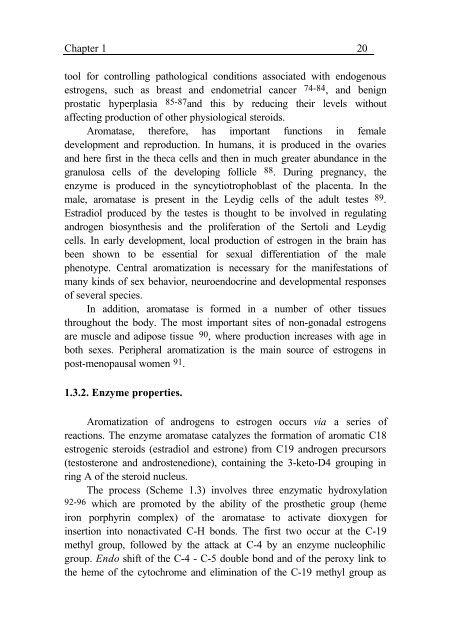Advances in the stereoselective synthesis of antifungal agents and ...
Advances in the stereoselective synthesis of antifungal agents and ...
Advances in the stereoselective synthesis of antifungal agents and ...
Create successful ePaper yourself
Turn your PDF publications into a flip-book with our unique Google optimized e-Paper software.
Chapter 1 20tool for controll<strong>in</strong>g pathological conditions associated with endogenousestrogens, such as breast <strong>and</strong> endometrial cancer 74-84, <strong>and</strong> benignprostatic hyperplasia 85-87<strong>and</strong> this by reduc<strong>in</strong>g <strong>the</strong>ir levels withoutaffect<strong>in</strong>g production <strong>of</strong> o<strong>the</strong>r physiological steroids.Aromatase, <strong>the</strong>refore, has important functions <strong>in</strong> femaledevelopment <strong>and</strong> reproduction. In humans, it is produced <strong>in</strong> <strong>the</strong> ovaries<strong>and</strong> here first <strong>in</strong> <strong>the</strong> <strong>the</strong>ca cells <strong>and</strong> <strong>the</strong>n <strong>in</strong> much greater abundance <strong>in</strong> <strong>the</strong>granulosa cells <strong>of</strong> <strong>the</strong> develop<strong>in</strong>g follicle 88. Dur<strong>in</strong>g pregnancy, <strong>the</strong>enzyme is produced <strong>in</strong> <strong>the</strong> syncytiotrophoblast <strong>of</strong> <strong>the</strong> placenta. In <strong>the</strong>male, aromatase is present <strong>in</strong> <strong>the</strong> Leydig cells <strong>of</strong> <strong>the</strong> adult testes 89 .Estradiol produced by <strong>the</strong> testes is thought to be <strong>in</strong>volved <strong>in</strong> regulat<strong>in</strong>g<strong>and</strong>rogen biosyn<strong>the</strong>sis <strong>and</strong> <strong>the</strong> proliferation <strong>of</strong> <strong>the</strong> Sertoli <strong>and</strong> Leydigcells. In early development, local production <strong>of</strong> estrogen <strong>in</strong> <strong>the</strong> bra<strong>in</strong> hasbeen shown to be essential for sexual differentiation <strong>of</strong> <strong>the</strong> malephenotype. Central aromatization is necessary for <strong>the</strong> manifestations <strong>of</strong>many k<strong>in</strong>ds <strong>of</strong> sex behavior, neuroendocr<strong>in</strong>e <strong>and</strong> developmental responses<strong>of</strong> several species.In addition, aromatase is formed <strong>in</strong> a number <strong>of</strong> o<strong>the</strong>r tissuesthroughout <strong>the</strong> body. The most important sites <strong>of</strong> non-gonadal estrogensare muscle <strong>and</strong> adipose tissue 90 , where production <strong>in</strong>creases with age <strong>in</strong>both sexes. Peripheral aromatization is <strong>the</strong> ma<strong>in</strong> source <strong>of</strong> estrogens <strong>in</strong>post-menopausal women 91 .1.3.2. Enzyme properties.Aromatization <strong>of</strong> <strong>and</strong>rogens to estrogen occurs via a series <strong>of</strong>reactions. The enzyme aromatase catalyzes <strong>the</strong> formation <strong>of</strong> aromatic C18estrogenic steroids (estradiol <strong>and</strong> estrone) from C19 <strong>and</strong>rogen precursors(testosterone <strong>and</strong> <strong>and</strong>rostenedione), conta<strong>in</strong><strong>in</strong>g <strong>the</strong> 3-keto-D4 group<strong>in</strong>g <strong>in</strong>r<strong>in</strong>g A <strong>of</strong> <strong>the</strong> steroid nucleus.The process (Scheme 1.3) <strong>in</strong>volves three enzymatic hydroxylation92-96 which are promoted by <strong>the</strong> ability <strong>of</strong> <strong>the</strong> pros<strong>the</strong>tic group (hemeiron porphyr<strong>in</strong> complex) <strong>of</strong> <strong>the</strong> aromatase to activate dioxygen for<strong>in</strong>sertion <strong>in</strong>to nonactivated C-H bonds. The first two occur at <strong>the</strong> C-19methyl group, followed by <strong>the</strong> attack at C-4 by an enzyme nucleophilicgroup. Endo shift <strong>of</strong> <strong>the</strong> C-4 - C-5 double bond <strong>and</strong> <strong>of</strong> <strong>the</strong> peroxy l<strong>in</strong>k to<strong>the</strong> heme <strong>of</strong> <strong>the</strong> cytochrome <strong>and</strong> elim<strong>in</strong>ation <strong>of</strong> <strong>the</strong> C-19 methyl group as















